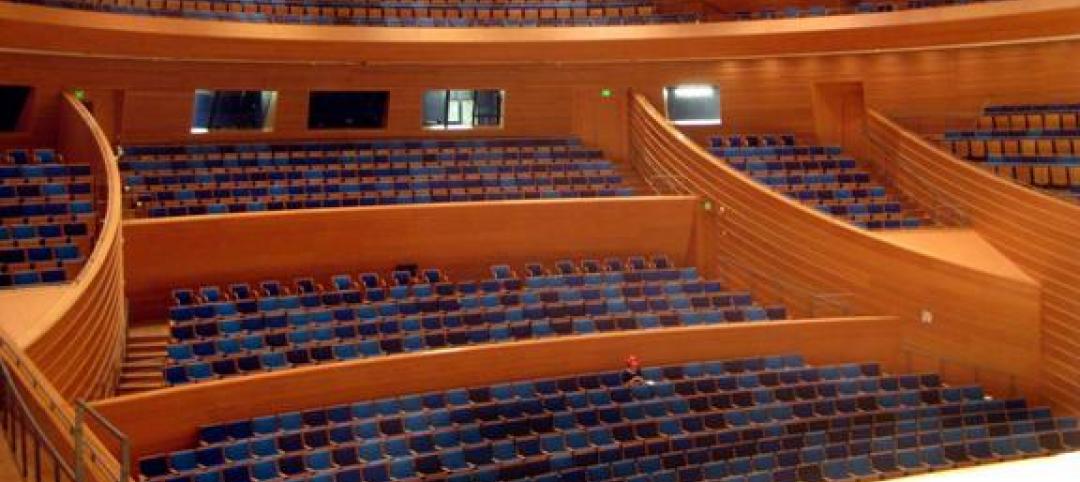The University of Toronto recently completed construction of a new addition to its School of Architecture. The top floor of the new Daniels Building features an expansive 16,000-square-foot open space designed to function as a studio and study hall. The space features no interior walls or structural columns.
Towering above the massive space is a very contemporary drywall ceiling designed to replicate wings. Hyperbolic paraboloid in shape, four angled drywall ceiling slabs gently twist from one side of the space to the other.
Creating the complex framing on which to attach the drywall was a key consideration. Project designers initially considered metal studs. However, a number of factors presented potential problems, including the overall size and twist of each ceiling surface.
According to Robert Dell’Elce, Vice President of Nelmar Drywall Company of Vaughan, Ontario, “Once we saw the initial drawings, we had our doubts it could be done with metal studs because of all the twists and turns.”
To find an alternative, the drawings were sent to Armstrong Ceiling Solutions to see if a drywall grid system was feasible. “We were familiar with drywall grid from a previous project and thought it would work here because of the flexibility it offered compared to metal studs,” he says.
 The drywall grid system maintained the curvature of the ceiling very well, even without wetting the 5/8” drywall.
The drywall grid system maintained the curvature of the ceiling very well, even without wetting the 5/8” drywall.
Full-Scale Mock-Up Created
In order to ascertain that drywall grid would perform as desired, Armstrong Ceilings created a full-scale mock-up at the local union training center. “The mock-up showed that the framing was possible using drywall grid and that gave us a level of confidence to proceed,” Dell’Elce says.
Following approval for its use, an initial challenge was the fact that this would be the first time many of the installation crews would be working with drywall grid, let alone on such an unusual shape. To remedy this, Armstrong Ceilings held on-site training sessions to help ensure a hassle-free installation. “The jobsite training we received was a huge help,” Dell’Elce states, “otherwise it could have been a nightmare.”
Foreman Chris Morgan notes that the crews learned the technique quickly since “everything essentially snaps together just like normal T-bar grid systems.” Because of the ease and speed of installation, he estimates the drywall grid system probably installed in half the time as the original steel stud system, significantly reducing labor on the project.

Morgan also notes that the drywall grid system maintained the smooth curvature of the ceiling very well, even with 5/8” drywall. “We were surprised how well the drywall mirrored the curve of the ceiling without having to wet it,” he states.
Looking back at the project and his first experience with a drywall grid system, Morgan states, “I would use it anytime I can now, especially in curved situations. I was amazed it worked so well.”
And as far as the future, Dell’Elce notes that the system is definitely increasing in use, stating, “Drywall grid is becoming much more common now as more and more architects become familiar with it.”
For additional information on Armstrong® Drywall Grid Systems, visit armstrongceilings.com/drywallgrid.
Related Stories
| Dec 14, 2011
Tyler Junior College and Sika Sarnafil team up to save energy
Tyler Junior College wanted a roofing system that wouldn’t need any attention for a long time.
| Dec 10, 2011
10 Great Solutions
The editors of Building Design+Construction present 10 “Great Solutions” that highlight innovative technology and products that can be used to address some of the many problems Building Teams face in their day-to-day work. Readers are encouraged to submit entries for Great Solutions; if we use yours, you’ll receive a $25 gift certificate. Look for more Great Solutions in 2012 at: www.bdcnetwork.com/greatsolutions/2012.
| Dec 5, 2011
Summit Design+Build begins renovation of Chicago’s Esquire Theatre
The 33,000 square foot building will undergo an extensive structural remodel and core & shell build-out changing the building’s use from a movie theater to a high-end retail center.
| Nov 29, 2011
First EPD awarded to exterior roof and wall products manufacturer
EPD is a standardized, internationally recognized tool for providing information on a product’s environmental impact.
| Nov 28, 2011
Armstrong acquires Simplex Ceilings
Simplex will become part of the Armstrong Building Products division.
| Oct 17, 2011
THOUGHT LEADER: Allan Bilka, Senior Staff Architect and Secretariat to the IGCC
Allan Bilka, RA, is a Senior Staff Architect and Secretariat to the International Green Construction Code (IgCC) with the International Code Council, based in the ICC’s Chicago district office. He also serves as staff liaison to the ICC-700 National Green Building Standard. He has written several ICC white papers on green building and numerous green-related articles for the ICC. A registered architect, Bilka has over 30 years of combined residential design/build and commercial consulting engineering experience.
| Sep 27, 2011
Steel Joist Institute announces October webinar on Open Web Steel Joists
Webinar participants can earn 0.15 CEUs or 1.5 PDHs.
| Sep 12, 2011
Morgan Thermal Ceramics’ system for installing grease duct enclosures achieves UL listing
Updated installation results in 33% space savings.
| Sep 9, 2011
Kauffman Center for the Performing Arts in Kansas City opens this month
Theatre Projects played the lead role in theatre design and planning as well as in engineering the customized theatre equipment. BNIM in Kansas City served as the executive architect.
















